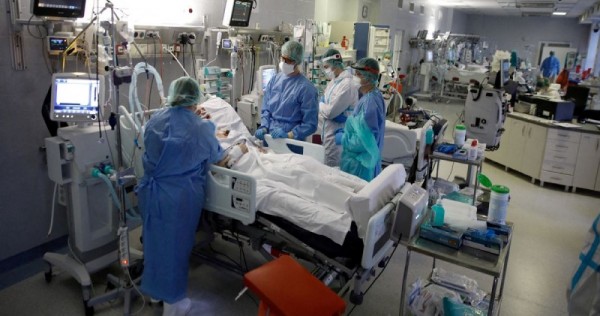MADRID/LONDON — Using the number of people in hospital with Covid-19 to gauge the severity of the pandemic may not give an accurate picture in the Omicron era as more and more patients with the virus are being admitted for other reasons, some scientists say.
Governments have focused on hospitalisations to determine the need for restrictions but the data does not typically differentiate between people admitted because of Covid-19, and those who test positive on wards during routine checks.
“Say you’re having a heart attack, come into hospital, and end up testing positive,” said Paul Hunter, a professor of medicine at Britain’s University of East Anglia.
“Is Covid-19 the cause of your heart attack? We know it could be. But we can’t know at an individual level,” he said.
In Britain, the Omicron variant has driven case numbers to record highs since it emerged at the end of November but the number of hospital patients with Covid-19 on mechanical ventilation has barely changed, government data shows.
The number of people with Covid-19 in hospital overall has risen, but not proportionately with the rise in infections, while intensive care unit (ICU) occupancy is little changed, according to British Health Minister Sajid Javid.
With death rates relatively stable despite the Omicron surge, some countries such as Spain are looking at whether to adopt new ways of tracking the virus, though epidemiologists say shifting the goal posts does not change the fact hospitals and their staff are still overloaded with Covid-19 sufferers.
Data from New York this month showed that 42 per cent of patients hospitalised with Covid-19 were so-called incidental cases, people admitted for other reasons and only found to be infected during routine testing.
British Prime Minister Boris Johnson even said last week that as many as 30 per cent of people in hospital with Covid-19 actually become infected while hospitalised — something Hunter partly attributed to Omicron’s overwhelming contagiousness.
SYSTEM OVERHAUL
Hunter said intensive care occupancy was a better measure of the real severity of an outbreak: “If you’re in an ICU bed with Covid, you’re probably there because of Covid, rather than just with it.”
In Italy, regional governments have argued that the nuances within the statistics on coronavirus hospitalisation may warrant overhauling their monitoring systems to better reflect the relatively lower severity of Omicron.
Italy’s Health Ministry said last week it was examining a draft proposal from the regions to exclude asymptomatic people hospitalised for other reasons from the COVID admissions data.
Critics denounced the proposal as a non-scientific bid by the regions to avoid hitting “red zone” levels of hospitalisations that would trigger tighter coronavirus curbs.
“The change in criteria cannot be a make-up operation that disguises the tragic nature and scale of the pandemic,” Filippo Anelli, president of Italy’s national federation of doctors, said on Friday (Jan14).
“The numbers of infected people admitted to non-critical areas and intensive care units, however they are counted, are overloading hospitals … and exhausting the professionals who have been managing the pandemic for two years,” he said.
The committee of scientists advising the Italian government recommended on Saturday that the current criteria measuring the spread of Covid-19 be maintained. The Health Ministry said, however, that the “preliminary” debate was ongoing.
The question of how to classify patients in hospital who are largely asymptomatic is set to preoccupy European nations as they look to ease curbs – even though it remains unclear to what extent Omicron may have exacerbated their medical conditions.
FROM IRELAND TO SPAIN
In Ireland, 58 per cent of those in hospital testing positive did not have any symptoms, according to the Infectious Diseases Society of Ireland, which looked at about 45 per cent of all positive Covid-19 cases admitted to Irish hospitals on Jan 11.
It found more than 70 per cent of those hospitalised with Covid-19 did not need oxygen therapy, suggesting they suffered from a less severe form of disease than previously seen.
In Denmark, about 15 per cent of people hospitalised people over the course of 18 months had tested positive for coronavirus, but displayed no symptoms and had been admitted for other reasons, a study published this month by the country’s top infectious disease authority the Statens Serum Institut showed.
In Spain, meanwhile, more than 18,800 people currently in hospital have Covid-19, a 79 per cent increase on previous peaks.
However, 25 per cent to 40 per cent of those testing positive in hospital were not being treated for Covid-19, according to a report in newspaper El Pais this month.
“40 per cent of patients hospitalised in Madrid with positive PCR tests aren’t (being admitted) for Covid,” Madrid’s deputy health counsellor Antonio Zapatero said last week on Twitter.
But Simon Clarke, associate professor in cellular microbiology at Britain’s Reading University, said even if Covid-19 levels in hospital partly reflected the prevalence of the virus in the population, they ought not be dismissed.
“There’s this narrative that if you come into hospital and pick up Covid it’s like a free infection and often dismissed, whereas that’s not true: you come into hospital for a reason, you’re vulnerable, and it’s likely Covid will worsen your condition,” Clarke said.
“There needs to be a recognition that regardless of admission reason, people in hospital with Covid is pressure on the hospitals.”
This article was first published in Asia One . All contents and images are copyright to their respective owners and sources.











